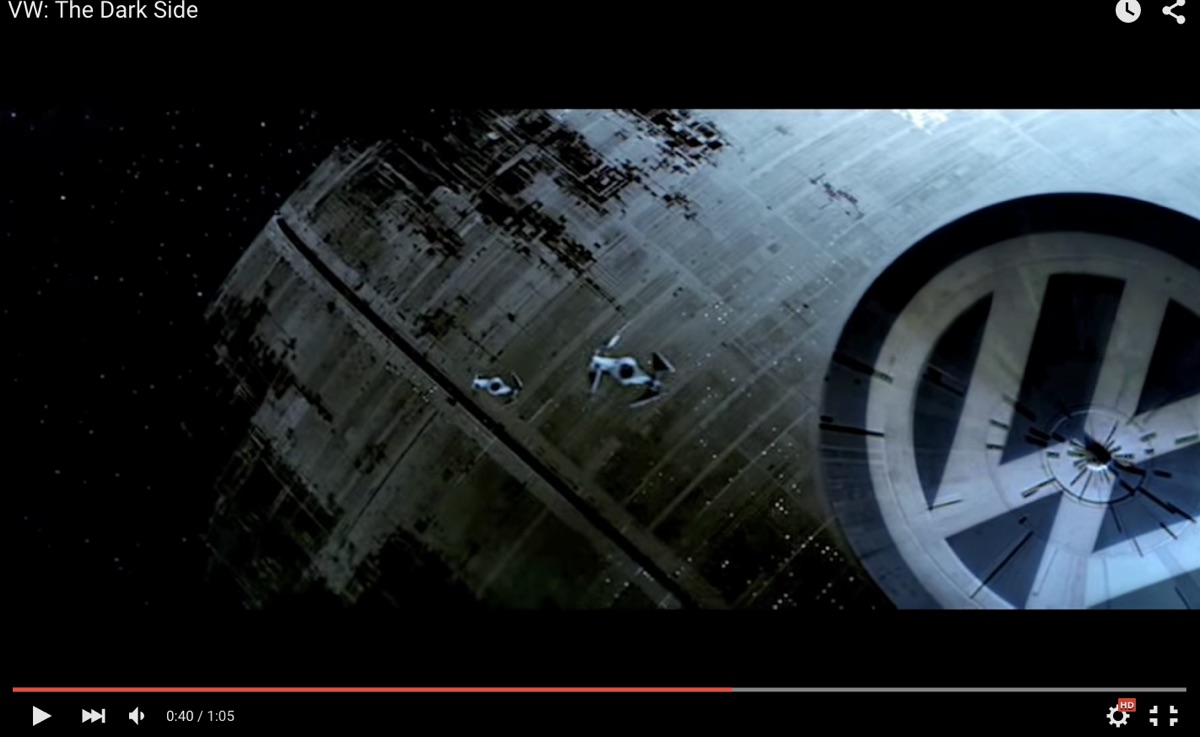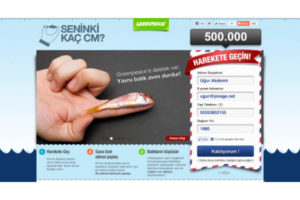On March 6, after two years of campaigning, Europe’s biggest carmaker Volkswagen has committed to ensure its cars meet strong CO2 reductions targets.
This is the true tale about how a highly-motivated, environmentally-minded rebel force was able to help one of the world’s most recognizable brands turn from the Dark Side of greenhouse gas emissions to a more enlightened path of planetary well-being.
A [not very] long time ago, in [this particular] galaxy . . .
It is a time of emissions enlightenment! The European Union (EU) has voiced a commitment to reduce greenhouse gas emissions, and recognizes that establishing new emissions standards for the continent’s many automobiles is an imperative.
To triumph, leadership of the many homeworlds that constitute the EU know they must make an ally of the powerful European Automobile Manufacturers’ Association (ACEA) if they hope to establish standards that will slash insidious emissions.
Winning over the ACEA is critical because it wields powerful influence over the government of one of the strongest auto manufacturing realms — Germany.
The key to winning over the ACEA means making an ally of its most influential member, a renowned automobile company that occupies more than a quarter of the seats within the ACEA: Volkswagen (VW).
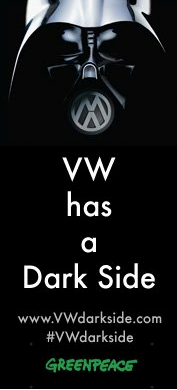
An Appealing Ask
VW represented an intriguing target for Greenpeace. It wasn’t about going after a petroleum company, which is arguably easier to set up as the quintessential malicious corporate edifice.
This campaign would require approaching and influencing one of the world’s most recognizable brands, and one that has cultivated a progressive, environmentally engaged image at that.
That provided campaigners with a strong hook however. They could craft messaging that urged, above all, that VW to simply live up to its rhetoric.
But even with that seemingly benign positioning, the messaging would need to be delivered with utmost attention to tone as well as content. Greenpeace wouldn’t want to alienate VW, but they couldn’t risk boring people to death either.
As luck (or The Force) would have it, VW had already set the tone with an indelible pop culture reference that made its most powerful impact during the Super Bowl.
Viewers everywhere laughed at the diminutive Darth Vader marvelling at his own powers to blink the lights on dad’s VW. The company wasn’t afraid of pop culture references, so why not simply explore and heighten the very frame of reference they established?
What would work?
A call to the company’s conscience urging them not to give in to…The Dark Side.
Social Media Stats
- 18k tweets using #vwdarkside from June- Dec., 2011[source: Topsy.com]
- 12k tweets on #greenpeace for same period [source: Topsy.com]
- 74k fans to Facebook campaign page, who themselves have 20.3 million friends.
- Weekly reach of page about 30k.
- 62k people visited film competition site – 16k of them voted
- 2 million+ views to main campaign films. It is difficult to get accurate numbers since there are over a hundred clone versions that were uploaded to YouTube and Vimeo when the video was taken down by LucasFilms. [source: YouTube & Vimeo search]
Squeeze your Org for Ideas
To get VW to jump ship and join the rebellion, Greenpeace first sought counsel from outside the organization. Campaign planners met with many agencies, explaining that, according to head of mobilisation at Greenpeace United Kingdom James Sadri, they had “the mother of all corporate targets — the VW account — can you help us?”
James and his team made it clear that the effort shouldn’t be about demonizing VW or attacking them as an ominous corporate entity.
“This effort had to be about a larger idea, a greater good,” James explained. “We wanted to start a conversation that would discuss positive change, even redemption on a personal as well as corporate level.”
The ad agencies fell short of appealing to the higher call. That’s when Greenpeace U.K. corralled a mass office brainstorm. It was a filmmaker working with Greenpeace who suggested the campaign play off the already massively popular Superbowl ad.
It was a reminder for James that while Greenpeace often seeks out ad and creative agencies, the organization has plenty of talented staff and partners worth squeezing for ideas.
With that thematic angle of attack in place, the decision to meet VW on its own Star Wars themed ground gained real internal traction.
What Worked Well
- The campaign engaged a huge amount of people through the digital side of this campaign; more than 5.5 million people visited the campaign website.
- The competitive/gaming element drove traffic; nearly 80% came through referring sites, mainly Facebook and Orkut
- An easily translatable website allowed lots of NROs to get on board at short notice
- Honour of being a Jedi Knight combined with t-shirt giveaways proved to be powerful incentive
- Splitting the campaign film into two parts was incentive for people to sign up (and watch part 2)
- Film competition was a great way of getting new creative content into the campaign
- Having a cross-country digital working group worked well
Rebel Alliance Attacks
To convey the point without alienating either VW or the audience, the campaign needed to stay as lighthearted yet culturally recognizable as the initial VW Super Bowl ad. The core content became a two-part video that shows the VW Death Star plotting to destroy the planet. Volkswagen’s de facto spokesperson, a pintsized Sith lord, squares off with heroes of the Rebel Alliance, including kid-form versions of Chewbacca, C-3PO, R2-D2, Princess Leia and a Jedi Knight.
The video ends with a message about VW’s opposition to cutting CO2 emissions from cars, and engages people with one simple ask: join the rebellion and turn VW away from the Dark Side.
Once members of the Rebel Alliance, supporters would get to see the second film and conclusion of the Darth Vader and Rebel Alliance stand-off.
A Galaxy of Mobilisation Tactics
After signing on to the manifesto at VWdarkside.com calling on Volkswagen to ensure its cars meet strong CO2 reductions targets, people are asked to help build the movement. James describes the simple ask giving way to a complex suite of actions where users could rack up points based on their activity.
The model was a direct copy of Greenpeace Mediterranean’s How Big is Yours? Campaign, where people were asked to grow their virtual fish to a healthy size by enlisting their friends and networks to sign the petition.
Like How Big is Yours, The VW Darkside site made learning about a serious issue entertaining. There was ‘ask Yoda to explain the Rebellion,’ in Yoda speak, and a full page focus describing how the Light Side of the Force is clean, green and renewable while the Dark Side is accelerating the rush for dead, dirty energy.
Then there was the allure of Jedi Training, a game rewarding people for campaigning. Users start as a ‘Youngling,’ and can progress to be a ‘Baby Ewok,’ eventually working their way towards Jedi hood. At every stage of the game, Jedi are encouraged to share the campaign with their networks for additional points. The competitive gaming element would prove essential in driving traffic; nearly 80% came through referring sites, mainly Facebook and Orkut.
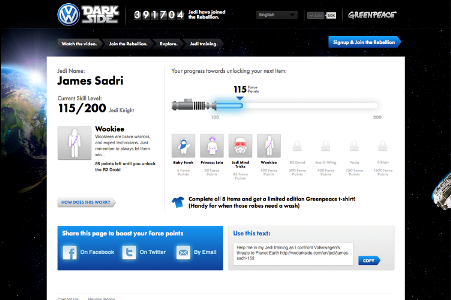
In order to create the right tone and feel to effectively engage supporters in the campaign, James says the team immersed themselves in the concepts, and “had fun with it.”
It worked. The day the campaign launched, 130,000 viewed the film and 400,000 people visited VWDarkside.com. The video instantly went viral, becoming the most shared ‘ad’ worldwide.
Thirty per cent of the people who signed the manifesto also took part in Jedi training, increasing the reach of the message among their social networks. Hugh Mouser, EU Powershift Digital & Mobilisation Co-ordinator for VW Darkside, says the large numbers were instrumental in giving the movement power.
Every signature added to the rebel manifesto was sent to the Martin Winterkorn, chairman of the Board of Management of Volkswagen, which gave them a real-time sense of the public’s growing opposition.
In total, 526,000 people would sign the rebel manifesto calling on Volkswagen to make their cars more efficient.
What Could Have Been Better
The campaign, while boasting tremendous initial audience engagement, lost more than 65% of its Jedi once they signed up to the campaign. Reasons for this were myriad, but strategies that would have lowered this number include:
- More consistent, provocative ways to prompt Jedi participation in real-world activities
- Automatic opt-in features that ensured Jedis received campaign updates and engagement prompts through regular e-news communication
- The campaign could have better mined Jedi data, collecting phone data during initial sign-up, for example. One reason for this shortcoming was that individual Greenpeace offices were responsible for continued outreach to their respective Jedi. A possible solution for similar efforts would be keeping communications with recent recruits to the initial campaign, and handing them over to individual offices only after they are developed into “Jedi Masters.”
- The campaign took too long to respond to the Greenpeace VW film being taken down by George Lucas and didn’t use that opportunity enough to pressure VW.
Nimble Digital Mobilisation Team
Even though the VW campaign’s mobilisation team was spread across countries and time zones, the group of three including James Sadri, Clemence Lerondeau from Greenpeace France, and Benjamin Borgerding from Greenpeace Germany, were able to collaborate and create first-class interactivity and gaming elements that engaged thousands of people. James says part of the digital team’s success was they had plenty of freedom to experiment, as the digital work wasn’t viewed as important as the campaign film, for example.
The team built a game system from scratch using the open-source web application framework Ruby on Rails. One of the advantages to using Ruby on Rails is apps can be instantly deployed on Heroku. Heroku allows users to run any web or background process with any web framework or worker type and get direct, granular control over the app’s workloads. On Heroku, users can also create testing, staging, and production versions of their app and deploy to and between them instantly.
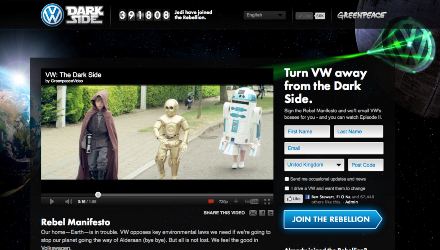
James says making the decision to use a separate system from the Greenpeace content management system can be difficult as in order to make something sustainable over time it needs to be built through existing processes. However, the VW team needed a quick turnaround while having full control of the platform and close contact with the developer, which Ruby on Rails and Heroku provided.
This system would facilitate the VW campaign deployment across 14 different languages and mobile platforms.
The online mobilisation team also left space to plan digital elements after the campaign’s launch as it’s often difficult to predict how people will respond. This enabled the team to play off real-time campaign energy, creating new tactics like a social media hijack using a Facebook Slicer, video competition, and a live Twitter map for the EU day of action ( all featured below).
“We kept asking ourselves, ‘Ok, what are we going to do next?’” says James, adding the group spent a weekend together brainstorming ideas.
The digital mobilisation attracted attention with a Volkswagen staff member contacting Greenpeace in confidence to let them know how influential the campaign was. VW communications staff were giving hourly updates on social media activity to the VW head office when the VW Darkside campaign launched.
In comparision, Volkswagen staff needed to sign off on tweets and Facebook posts two weeks in advance. James says this gave Greenpeace an advantage, engaging the public in a personal way as opposed to Volkswagen, which from a public’s perspective stayed silent on the issue during the campaign.
“I think it’s important to underline the fact that that those very processes (like a two-week sign off) are what make corporations slow and sluggish and non-human,” says James.
Successes and Shortcomings
The VW victory is the result of two years of experimenting with new and old mobilisation tactics. Here’s a run-down of some of the most powerful tools and learnings from the VW campaign:
Conspicuous Launch Combine with Strong Social Media
The VWDarkside campaign was launched at Old Street, the centre of the U.K. digital marketing world. Featuring 65 people on the ground, four giant billboards and 15 imposing stormtroopers clad in white armour, the launch ensured both ‘Stormtrooper’ and ‘Old Street’ were two terms that were trending globally on Twitter, pushing the campaign to audiences who wouldn’t have otherwise seen it.
As a result, the campaign team encourages others to consider a launch strategy that incorporates social media focused on a key audience that can spread the message.
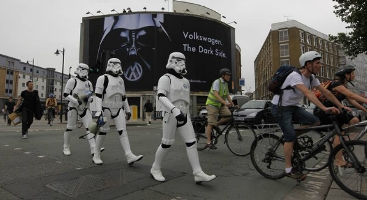
The Opt-In Quandary
When Greenpeace launched vwdarkside.com, some offices wanted the ‘opt-in to updates’ checkbox on the signup form to be pre-checked, others said it’s against their national law, for others it wasn’t clear. This fueled more than a bit of internal debate about the best design approach, and even brought forth the suggestion of excluding the opt-in box altogether.
Leaving the opt-in box unchecked proved to be the best option, but the reality was that the campaign lost communication with almost 70 per cent of its signups immediately. Out of nearly 500,000 Jedi, that’s a sizeable amount of prospective influence left unrealized.
In comparison, when Greenpeace launched its film competition (featured below) it tested not telling people that their phone number was optional in the sign-up form. They found that around 70% entered their phone number when it didn’t say it was optional (even though it was), but that dropped to around 15% when Greenpeace made the option explicit.
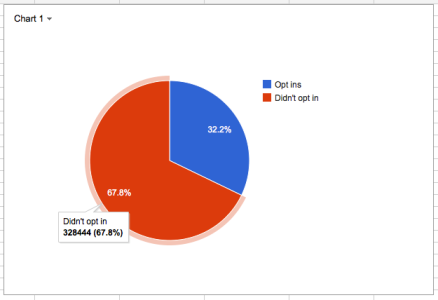
Many organizations — like Avaaz —don’t include opt-in boxes at all and just explicitly say that by signing up you consent to being sent information. In light of the VW experience, James would recommend this option.
The Email Nurture Campaign
Greenpeace national office capacity had a profound effect on e-mail outreach. Depending on available resources, some Jedi received as many as 18 emails; others had less than three reach their in-boxes.
A big reason for the falloff in email frequency was an erroneous presumption that offices would simply clone, and if necessary translate emails, and then send them out to their Jedi. In reality, it takes a fair amount of time to setup a mass email, particularly when there is a related email action attached. One remedy would be to dedicate someone to co-ordinating international communications, including supporting unique needs of different offices and driving comparable campaigns.
Declining Email Readership
As is typical of multi-touch email efforts, there was a general downward trend in open- and and click-through rates over the campaign’s six months.
In the U.K. office, for example, average open and click-through rates were 37% and 9% respectively, essentially a bit higher than the office’s other campaigns, which averaged 30% and 8%.
Facebook Slicer Showdown
Greenpeace U.K. developed a tool for splitting images into 9 smaller ones which, when uploaded in order, would make a larger picture on VW’s Facebook page. It proved an effective, attention-getting way to insert a provocative visual at the top of the page — so much so that VW changed is Facebook page policy soon after.
The tool is still around (with the code) for other campaigns to use.
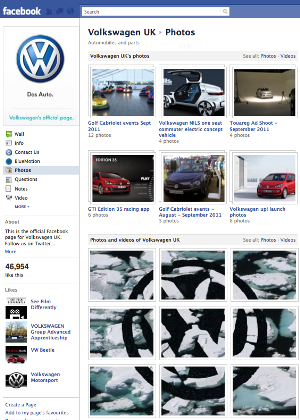
Live European Action Map
For the campaign’s European-wide day of action in September, 2011, GP U.K. created a live-action map to which a visitor could send a geolocated Tweet, or add a message from their computer. The challenge was tying this into the locations where volunteers were covering VW cars at dealerships.

It all worked off a complex matrix of Twitter hashtags. It was an exciting way of displaying the action content, if a little buggy. The internal consensus is the map would work very well in support of Greenpeace live action work.
Prepare for Zealous Fans
The Jedi training was a huge success in driving traffic to the site, but there were a few lessons we learned:
People cheat.
Campaign leadership tried to thwart cheaters, but people proved to be incredibly creative in finding ways to work around the system. In the end the team found a long-lasting solution but don’t underestimate what people will do!
Games make people passionate.
As expected of any passionate fan base, Star Wars afficionados can operate on a spectrum from enthusiastic to zealous to obsessive. Sometimes, harnessing that kind of loyalty works well, but it can be a blessing and a curse. There were plenty of instances where a raging teenager or cultish fan took it upon his or herself to hijack Facebook posts.
Supporter services will be dealing with lots of gamers.
The supporter services team received numerous inquiries in lots of languages about people’s Jedi pages and their t-shirts. Make sure your colleagues are happy with this element of a campaign before launch.
Film Removal Opportunity?
No doubt that the main campaign film was a huge driver of the initial momentum Greenpeace had in the campaign as the most shared ‘ad’ on the internet:
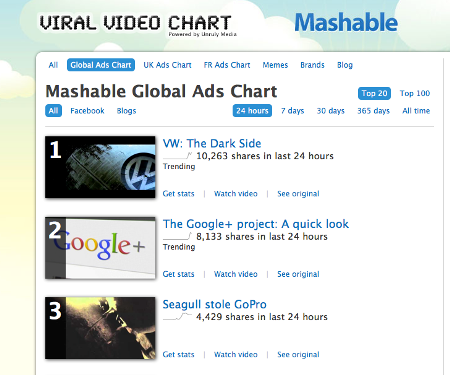
Unfortunately, when YouTube pulled the plug on the film it was being shared by close to 100k people on Facebook, which meant in all of those news feeds the film would have just been blank. The campaign didn’t take full advantage of that censorship to spur people to more action.
For example, Greenpeace could have suggested the Dark Side was using Jedi mind tricks to suppress the film but in the end chose a messy compromise and missed this opportunity. In hindsight, answering quickly, or simply asking viewers who they think took down the video could have capitalized on the campaign takedown while further building momentum against Volkswagen.
Despite this, the film has been uploaded in many places making it impossible to know how many times it’s been viewed. Two million plus views is considered a conservative estimate.
Film director: Jack Price
Filmmakers Join Rebellion
Greenpeace challenged filmmakers from around the world to help expose the real VW. The competition received 82 submissions, some very high quality. And while well done, none went viral.
Nevertheless, 62,000 people visited the film competition site and 16,000 people voted.
Fulfill Your Destiny
The VW committment to ensure its cars meet strong CO2 reductions targets on March 6 stems directly from the campaign’s ability to engage the public on the issue. On an international level the VW campaign engaged more than a half-million people — and via non-traditional channels.
“It’s fantastic to see that people power can shift one of the world’s super powers into a new brand position,” says Hugh. “It’s a brilliant example of a coherent campaign within an organization, and an amazing movement that took off based on a really strong concept and some exciting campaign tactics.”
James agrees. He says it’s important to note that the campaign’s success hinged on the combination of a strong theory of change (brand damage to the image-conscious Volkswagen) and smart, interactive game elements to engage people.
“It was very clear that you’ve got one of the world’s biggest advertisers who are very vulnerable on their brand. Therefore, getting more people to expose what they’re doing is going to make them very nervous,” says James.
“The central logic was strong, therefore all of the interactivity on top of that amplifies it but it doesn’t replace it.”
VW has now publicly agreed to live up to its promises to be the world’s greenest car company, setting an example for the rest of the industry.
The campaign to make car manufacturers raise their efficiency targets continues at the EU level.
For more, watch this video of a talk James Sadri recently gave at the 2013 eCampaigning Forum:
– By Jay Ferrari and the MobLab team
